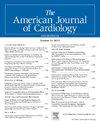心脏康复后死亡风险和功能能力改善与心力衰竭预后的相互作用。
IF 2.1
3区 医学
Q2 CARDIAC & CARDIOVASCULAR SYSTEMS
引用次数: 0
摘要
死亡风险是否与心脏康复(CR)后6分钟步行试验(6MWT)距离变化对心力衰竭(HF)预后的影响相互作用尚不清楚。我们研究了入住6个CR住院病房的1569例HF患者。在CR入院和出院时分别进行6MWT,主要结局为3年死亡率。使用Cox回归模型检验基线风险与6MWT距离增加50米对主要转归的交互作用,其中基线风险与增加50米之间存在交互项。为了进一步说明基线风险与6MWT距离变化之间的相互作用,将参与者分为低风险和高风险亚组。交互作用的p值为0.588。低危亚组3年死亡率为16.1%,高危亚组为53.7%。43.0%的低危患者和43.4%的高危患者6MWT距离增加≥50米。6MWT距离增加50米后,低危组患者3年死亡率校正危险比为0.67 (0.47-0.96,p= 0.030),高危组为0.75 (0.61-0.91,p= 0.005)。这些发现表明,无论基线死亡风险如何,CR后功能能力的改善与生存率的提高有关。本文章由计算机程序翻译,如有差异,请以英文原文为准。
Interaction of Risk of Death and Improvement in Functional Capacity After Cardiac Rehabilitation on Heart Failure Prognosis
Whether risk of death interacts with change in 6-minute walking test (6MWT) distance after cardiac rehabilitation (CR) on heart failure (HF) prognosis is unknown. We studied 1,569 patients with HF admitted to 6 inpatient CR units. A 6MWT was performed at admission to and at discharge from CR. The primary outcome was 3-year mortality. The interaction of baseline risk and 50-meter increase in 6MWT distance on the primary outcome was tested using a Cox regression model with an interaction term between baseline risk and 50-meter increase. To further illustrate the interaction between baseline risk and change in 6MWT distance, participants were stratified into low- and high-risk subgroups. The p value for the interaction was 0.588. Three-year mortality was 16.1% in the low-risk and 53.7% in the high-risk subgroup. 43.0% of the low-risk and 43.4% of the high-risk patients achieved an increase ≥50 meters in 6MWT distance. The adjusted hazard ratio of 3-year mortality for the patients who achieved a 50-meter increase in 6MWT distance was 0.67 (0.47–0.96; p = 0.030) in the low-risk and 0.75 (0.61–0.91; p = 0.005) in the high-risk subgroup. These findings suggest that improvement in functional capacity after CR is associated with improved survival regardless of baseline risk of death.
求助全文
通过发布文献求助,成功后即可免费获取论文全文。
去求助
来源期刊

American Journal of Cardiology
医学-心血管系统
CiteScore
4.00
自引率
3.60%
发文量
698
审稿时长
33 days
期刊介绍:
Published 24 times a year, The American Journal of Cardiology® is an independent journal designed for cardiovascular disease specialists and internists with a subspecialty in cardiology throughout the world. AJC is an independent, scientific, peer-reviewed journal of original articles that focus on the practical, clinical approach to the diagnosis and treatment of cardiovascular disease. AJC has one of the fastest acceptance to publication times in Cardiology. Features report on systemic hypertension, methodology, drugs, pacing, arrhythmia, preventive cardiology, congestive heart failure, valvular heart disease, congenital heart disease, and cardiomyopathy. Also included are editorials, readers'' comments, and symposia.
 求助内容:
求助内容: 应助结果提醒方式:
应助结果提醒方式:


